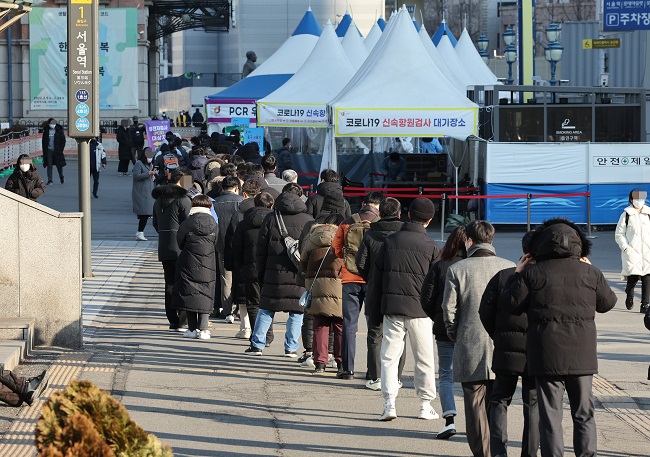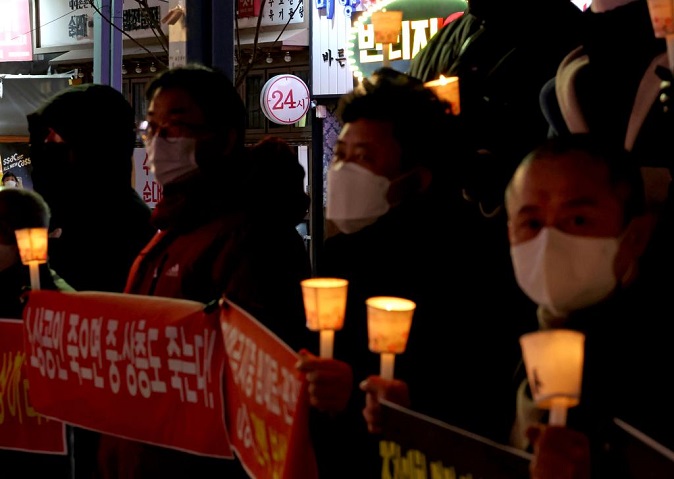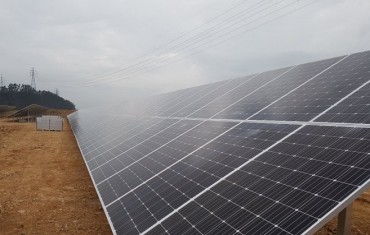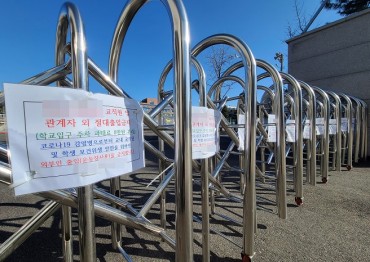
People wait in line to receive COVID-19 tests at a makeshift testing station in Seoul on Feb. 22, 2022. (Yonhap)
SEOUL, Feb. 22 (Korea Bizwire) — South Korea’s new COVID-19 infections surpassed 150,000 for the first time Tuesday amid the fast spread of the omicron variant across the country.
According to health authorities and local governments, a total of 158,005 cases had been confirmed nationwide as of 9 p.m., up 60,070 from 97,935 posted the same time the previous day. The previous daily high was set last Friday at 109,823.
The total number for Tuesday is expected to rise further, as daily cases are counted until midnight and announced the following morning.
Earlier in the day, the country reported 99,573 new COVID-19 infections, including 99,444 local cases, raising the total caseload to 2,157,734, according to the Korea Disease Control and Prevention Agency (KDCA).
New daily infections have risen at a fast pace in recent weeks, surpassing the 100,000 mark for the first time Friday. They remained above the threshold for two more days before falling to 95,362 on Monday due to fewer tests over the weekend.
The health authorities have warned that the caseload could spike further to as high as 270,000 by early next month due to the highly transmissible omicron variant.
The death toll from COVID-19 came to 7,508, up 58 from Monday. The fatality rate was 0.35 percent, according to the KDCA.
The number of critically ill COVID-19 patients came to 480, unchanged from a day earlier. The figure has been on a rise recently, staying above 400 since Saturday amid lingering concerns over a further uptick in line with the growth in total infections.

Officials prepare to send COVID-19 treatment packages to at-home treatment patients at a post office in Seoul on Feb. 22, 2022. The packages include fever reducers and a thermometer. (Yonhap)
Despite the latest wave of the virus infections, the government on Saturday extended the business hour curfews for cafes and restaurants by one hour to 10 p.m. in a move to support pandemic-hit merchants.
But it maintained the six-people cap on private gatherings and other antivirus restrictions, while vowing to be “flexible” by closely monitoring the virus situation.
The partially relaxed antivirus rules have spawned anxiety that infections could further increase going forward. The rules will remain in place until March 13.
“If we can keep the fatality rate at a lower level and stably maintain the current situation, we will be able to treat omicron just as other types of infectious diseases. We still have a long way to go, but it’s like we’ve begun our journey to an exit,” a health ministry official told a regular briefing.
“This omicron wave is a crisis in the short run, but it is a necessary process in a longer-term perspective to return to normalcy,” the official added.
Intensive care unit beds set aside for critically ill patients were 36.3 percent occupied nationwide, up 0.9 percentage point from the previous day.
Currently, a total of 69,797 people are on the authorities’ list of special monitoring, and the government has a capacity of managing up to 210,000 patients with extra care, the KDCA said.
The number of patients receiving at-home treatment rose to a fresh high of 490,322 on Tuesday, it added.

Self-employed workers stage a protest in Seoul on Feb. 21, 2022, to call for the lifting of the government’s restrictions on their business hours and compensation for losses due to the coronavirus pandemic. (Yonhap)
The recent upsurge has also deepened concerns, as well as complaints, over a shortage of staff at public health care centers in charge of conducting basic surveys on confirmed cases and extending supports.
“The government has been beefing up the personnel and will further boost cooperation with the internal affairs ministry to mobilize more workers. If your conditions worsen, you can reach local medical centers and get treatment pills,” the official said.
South Korea plans to bring in additional Paxlovid antiviral treatment pills for 40,000 people by around the end of this month.
The country has secured Pfizer’s medication for 762,000 people, and the pills for 32,000 patients have been brought in so far.
From Monday, the government began prescribing Paxlovid to COVID-19 patients in their 40s with underlying diseases.
Previously, the oral pills were prescribed only to those aged 60 and older, those with compromised immune systems and people in their 50s with underlying diseases.
As of Tuesday, 30.63 million people, or 59.7 percent of the country’s 52 million population, had received booster shots. The number of fully vaccinated people came to 44.31 million, accounting for 86.3 percent, according to the KDCA.
On Wednesday, a total of 615,000 doses of Pfizer’s COVID-19 vaccines will arrive in South Korea.
The planned shipment will raise the total amount of coronavirus vaccines delivered here to 7.58 million this year, with the country planning to bring in a total of 142.86 million doses this year, according to the KDCA.
(Yonhap)






